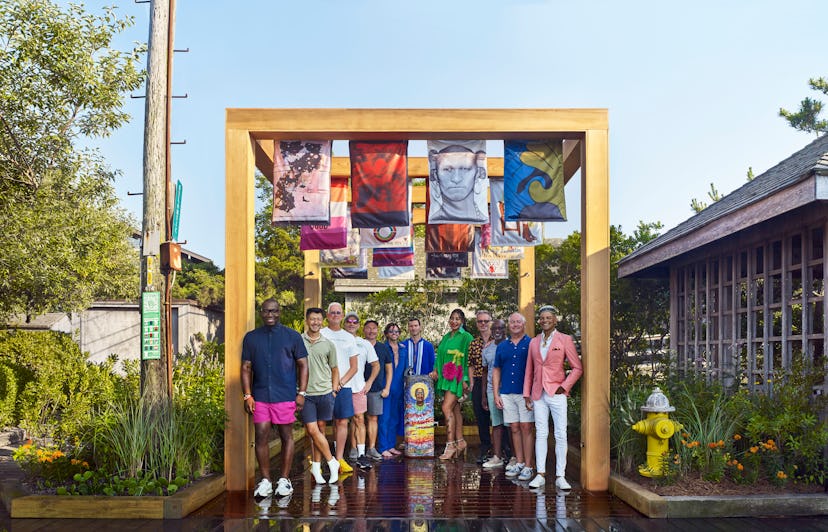At Trailblazers Park in Fire Island Pines, Queer Icons Get Their Due
The new permanent public space spotlights LGBTQ+ activists with installations from 16 artists including TM Davy, Nicole Eisenman, Wolfgang Tillmans, and more.

“You can’t just put Marsha P. Johnson and Sylvia Rivera’s names on a wall in Fire Island Pines and go, Oh, good, job is done!,” the artist TM Davy tells me during a recent Zoom call from his own home in the queer enclave off the southern shore of Long Island, New York. “Because the job isn’t done. That’s an insult to the legacy.”
With this credo in mind, Davy has spearheaded a new installation in Fire Island Pines Harbor alongside 16 contemporary artists, all of whom contributed original works for the outdoor exhibition. Titled “Trailblazers Park,” the permanent public space pays homage not only to trans activists Johnson and Rivera, but other queer pioneers including James Baldwin, Harvey Milk, and the Japanese-American author Kiyoshi Kuromiya. For this project, Davy himself learned how to mosaic in order to construct the dual drinking fountain that sits in the middle of a wooden platform designed and created by the architect Scott Bromley (who famously worked on constructing Studio 54). Upon the water fountain are multicolored images of Johnson and Rivera’s faces, surrounded by halos, rainbows, and light. Above the water fountain: those 16 flags created by artists like Wolfgang Tillmans, Carlos Motta, and Nicole Eisenman—all of whom were paired up with an individual queer trailblazer to honor with a work of art. (Tillmans focused on Kuromiya for his text-focused homage, while Motta captured Zuni Native American artist We’wha, and Eisenman—who is Davy’s former FIP roommate—gave tribute to the activist Edie Windsor.) Flowers and greenery that are native to the area grow every which way around the platform—having been carefully planted by Davy’s husband, Liam O’Malley-Davy, who runs the landscaping business Gay Gardens on Fire Island.
A look at Trailblazers Park.
On the day Davy and I meet for an interview, he’s in the middle of installing the water fountain in the park, which officially opened on July 16 with a party hosted by Fire Island Pines Property Owners Association, which commissioned Trailblazers Park. “The flags felt like the right idea because they’re waving and welcoming you as soon as you get off the ferry to Fire Island,” he says when I ask why flags were his artistic medium of choice. Meanwhile, the fountain offers both function (“The thought of someone leaving thirsty, while catching the last ferry of the day…no way!,” Davy says with a laugh) and a sincere homage to the women who inspired its creation. “I’ve had a lot of time to contemplate [Marsha P. Johnson and Sylvia Rivera],” Davy says. “It’s been beautiful to feel grateful to them.”
The visages of Marsha P. Johnson and Sylvia Rivera, done in mosaic. Photograph by Peter Murdock.
Trailblazers Park feels especially timely during a summer when Fire Island has gained newfound notoriety within the mainstream consciousness. Although a well-known destination for LGBTQ+ folks for decades, the wide release of the Joel Kim Booster and Bowen Yang film Fire Island thrust the location’s idiosyncratic culture into the spotlight. There’s also been a shift in the awareness of FIP residents and visitors, who are aiming to make the idyllic island a more inclusive space. Historically a haven for gay men—and, as Davy points out, white, wealthy, good-looking gay men especially—the artist says he isn’t so sure that, in the past, women and trans women were “always treated so well by this place.”
The Harvey Milk flag, by artist Hugo Gyrl.
“We are realizing this is a place where we can become a little bit closer to the dream we have for each other,” he says. “And if we are really dreaming together, it’s not that one thing that came to define it for a while. There is, in the air, a feeling like, ‘What are we still doing that for?’
“Through me, maybe, is an apology from this community—that [trans women] weren’t more welcome. Hopefully, their daughters are being made welcomed by their presence.”